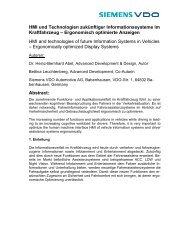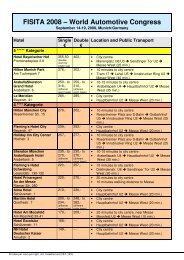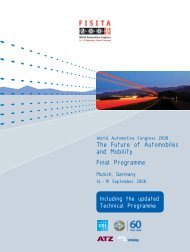viewed here - FISITA 2008
viewed here - FISITA 2008
viewed here - FISITA 2008
Create successful ePaper yourself
Turn your PDF publications into a flip-book with our unique Google optimized e-Paper software.
Automotive Aftermarket<br />
enhancement of the existing standards by a formalized language to describe<br />
diagnostic and functional sequences for production and service. Such a<br />
standardized test language opens an efficient information channel for<br />
diagnostic content from development to production and service. Diagnostic<br />
functions for service that are already verified and validated during<br />
development phase can be easily integrated in diagnostic testers in<br />
production and service without effort for re-implementation. Also a re-use of<br />
modular elements of diagnostic sequences over different vehicle models is<br />
possible.<br />
This state of information flow without gaps between development, production<br />
and service can only be achieved under the prerequisites that the whole<br />
diagnostic process is set up as an integrated process with adequate and<br />
efficient support by software tools for each single step. Here new solutions are<br />
required especially for development purposes. The contribution will present a<br />
new concept (figure 1) to satisfy the mentioned requirements. The single<br />
elements will be described in detail.<br />
The first step of diagnostic development is diagnostic analysis of new systems<br />
or of system variants. That is the analysis and assessment of diagnostic<br />
capability and the identification of diagnostic gaps. The following steps are the<br />
design of diagnostic functions and diagnostic architecture as well as the toolsupported<br />
development of functions to be used in the diagnostic tester. The<br />
interface between development and production or service is the creation of<br />
sequences for the guided trouble shooting. In this context it is especially<br />
necessary that the developer has the possibility to efficiently verify and<br />
validate the diagnostic functions on the “target platform” (diagnostic tester)<br />
already during function development.<br />
The presented concept is completed by the elements authoring system,<br />
runtime system, communication hardware and measurement devices. The<br />
backbone of the solution are the latest state-of-the-art standards to enable<br />
efficient generation and use of diagnostics.<br />
diagnostic<br />
analysis<br />
analysis<br />
tool<br />
diagnostic<br />
partitioning<br />
partitioning<br />
tool<br />
diagnostic<br />
development<br />
tester-fct.<br />
editor<br />
diagnostic<br />
content<br />
generation<br />
sequence<br />
editor<br />
diagnostic<br />
authoring<br />
authoring<br />
system<br />
validation and verification<br />
rollout session<br />
runtime system<br />
Figure 1: Integrated diagnostic development and deployment process and tool<br />
support<br />
ODX<br />
VCI<br />
26 October 2007<br />
Page 2 of 3






